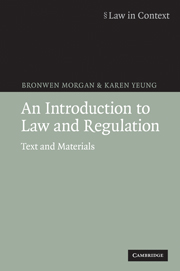Preface and Acknowledgements
Published online by Cambridge University Press: 05 June 2012
Summary
The origins of this book can be traced back to an informal conversation between us in 1999 as two young legal academics at Oxford University shortly after discovering our shared interest in the nature and workings of the administrative state. This prompted us to consider the possibility of putting together a postgraduate course with the rather broad title ‘Regulation’. As neither of us had previous experience in teaching such a course, we began somewhat tentatively, seeking to devise a course that would encourage students to interrogate legal institutions beyond the confines of a narrow focus on legal doctrine. Our ambition was to cultivate in our students what Roberto Unger calls an ‘institutional imagination’, one that highlights the challenges of institutional design in public policy-making and practice so as to enrich and enliven their understanding of the law and its contribution to the regulatory enterprise.
It was in the process of locating suitable material for our proposed course that we discovered the lack of any textbook to guide us and our students. Although there were several valuable essay collections, as well as books that adopted one particular disciplinary orientation in examining regulation, there was no single book which satisfactorily fulfilled our pedagogical objectives. What we wanted was a scholarly yet accessible text which both drew together a broad range of perspectives and examined a wide range of regulatory issues.
- Type
- Chapter
- Information
- An Introduction to Law and RegulationText and Materials, pp. xiii - xviPublisher: Cambridge University PressPrint publication year: 2007

